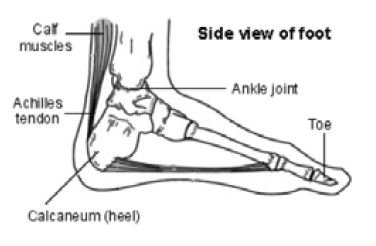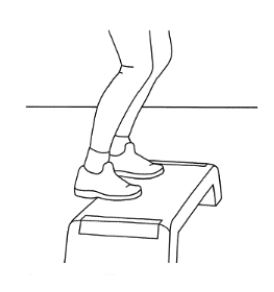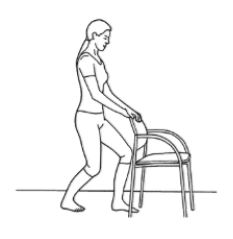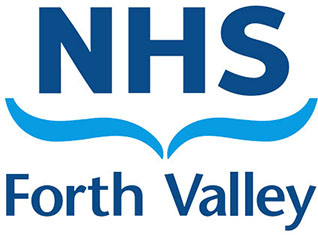The aim of this advice is to give you some understanding of the problems you have with your Achilles tendon and to provide some advice on how to manage this. It is not a substitute for professional healthcare advice and should be used in conjunction with the information you may have been given by your GP or AHP.
 What Is Achilles Tendinopathy?
What Is Achilles Tendinopathy?
Achilles Tendinopathy is a condition that can cause pain, swelling, stiffness and weakness of the Achilles Tendon, It is thought to be caused by repeated tiny injuries to the Achilles Tendon over time.
Causes
- Changes in footwear can affect e.g. flip flops, high heels, changes in trainers
- Foot position such as high arches or flat feet make it more difficult for the Achilles tendon to absorb load.
- Overloading of the tendon, such as prolonged periods of standing, walking, weight gain, running, jumping and increased intensity of training or sports.
- Stiffness or injury to any surrounding area such as the ankle, foot or calf.
What are the symptoms?
- Pain generally tends to be worse in the morning or during/after exercise.
- Some swelling, ‘thickening’ and pain can occur aroundthe tendon and calf area.
- The tendon may be very tender to touch and you may have increased discomfort wearing shoes that press against it.
What are the treatment options?
- Treatment is usually non-operative, symptoms can take some months to settle. It is important to reduce the load on the tendon.
- Rest and time off from sporting activities is important
- Footwear – Try alternative footwear with shock absorbing properties. Insoles may be helpful.
- Reducing weight – if you are overweight this can cause excess load on your tendon.
- Ice can sometimes be helpful in the early stages of Achilles tendinopathy to reduce pain. Only apply an ice pack if wrapped in a damp towel, and for no longer
than 20 minutes. Please check your skin regularly as ice can burn. - Pain medication. Discuss this with your GP or pharmacist.
- Injections (normally steroid and local anaesthetic) are rarely done on Achilles tendons, but you must have a scan first.
Surgical Treatment
This is rarely done and only if symptoms have been present for a very long time. You would need to see a specialist orthopaedic surgeon to discuss this.
Exercises
All exercises should be relatively comfortable to do. If you have pain on a specific exercise that does not settle quickly, you should stop that exercise.
 Exercise 1
Exercise 1
Stand with both feet at the edge of a step. Push yourself up onto your tip toes and slowly lower down both heels until your heels are below the edge of the step.
Once this exercise becomes easier repeat this exercise on the painful side only.
 Exercise 2
Exercise 2
Repeat exercise 1 with knees bent.
 Exercise 3
Exercise 3
Stand with affected leg behind the other leg, keeping the heel down on the floor and the knee straight.
Lean forward bending the front knee forward until you feel a stretch in your calf and Achilles tendon.
 Exercise 4
Exercise 4
Repeat as exercise 3 but with knee of affected leg slightly bent.
Medication
Many people use medication to help them remain active and to cope with their pain and symptoms. It is recommended that you take your medication regularly. It is best to get advice from a GP of pharmacist.

